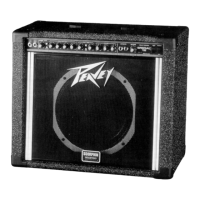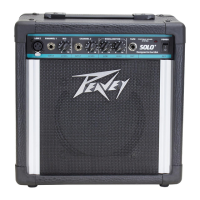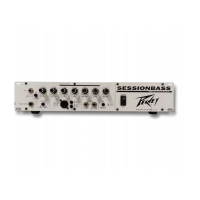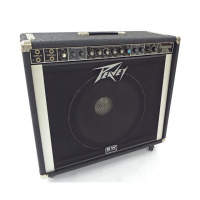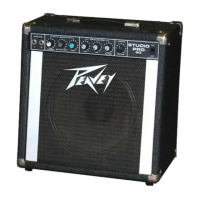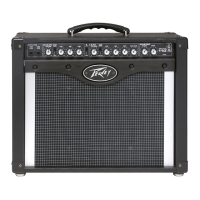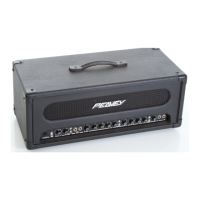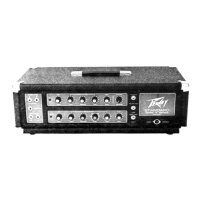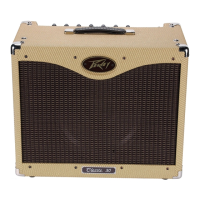Do you have a question about the Peavey Special 150 and is the answer not in the manual?
Used for most electric guitars, providing 6 dB louder output than the Low Gain input.
For instruments with extremely high outputs to prevent overdriving the High Gain input.
Controls the normal channel's volume level, unaffected by SuperSat or Post Gain.
Provides a preset +6 dB boost to treble frequencies when activated.
Selects between the lead or normal channel, can also be operated by remote footswitch.
Simulates tube distortion (soft clipping) and requires the lead channel to be activated.
Controls the overall volume level of the lead channel for final adjustment.
Output for supplying signals to external low-level effects or signal processing equipment.
Input for returning signals from external low-level effects or signal processing equipment.
Passive tone controls that regulate the low, mid, and high frequencies respectively.
Active tone control (+/-15 dB) varying the extreme high frequency range.
Controls the overall reverb level of the amplifier.
Illuminates when AC power is being supplied to the amplifier.
Three-position switch to minimize hum; not functional on 220/240 Volt models.
Activates the unit; red pilot light illuminates when power is supplied.
Use to connect line level signal directly to the power amplifier stage.
Routes the amplified signal to external devices like mixers or tape recorders.
Connection for the supplied footswitch to select channels and defeat reverb.
Features a 3-wire grounded line cord for safety and noise reduction (120V products).
Details rated power, load, clipping power, frequency response, and distortion.
Lists impedance and input levels for various preamp controls.
Describes EQ characteristics and external footswitch operations.
Warning to prevent electrical shock or fire hazard by avoiding rain or moisture.
Covers caution for electrical shock, water exposure, heat sources, and ventilation.
Advises on preventing hearing loss from high noise levels and recommended exposure limits.
Highlights maximum power operation risks and input signal strength considerations.
Used for most electric guitars, providing 6 dB louder output than the Low Gain input.
For instruments with extremely high outputs to prevent overdriving the High Gain input.
Controls the normal channel's volume level, unaffected by SuperSat or Post Gain.
Provides a preset +6 dB boost to treble frequencies when activated.
Selects between the lead or normal channel, can also be operated by remote footswitch.
Simulates tube distortion (soft clipping) and requires the lead channel to be activated.
Controls the overall volume level of the lead channel for final adjustment.
Output for supplying signals to external low-level effects or signal processing equipment.
Input for returning signals from external low-level effects or signal processing equipment.
Passive tone controls that regulate the low, mid, and high frequencies respectively.
Active tone control (+/-15 dB) varying the extreme high frequency range.
Controls the overall reverb level of the amplifier.
Illuminates when AC power is being supplied to the amplifier.
Three-position switch to minimize hum; not functional on 220/240 Volt models.
Activates the unit; red pilot light illuminates when power is supplied.
Use to connect line level signal directly to the power amplifier stage.
Routes the amplified signal to external devices like mixers or tape recorders.
Connection for the supplied footswitch to select channels and defeat reverb.
Features a 3-wire grounded line cord for safety and noise reduction (120V products).
Details rated power, load, clipping power, frequency response, and distortion.
Lists impedance and input levels for various preamp controls.
Describes EQ characteristics and external footswitch operations.
Warning to prevent electrical shock or fire hazard by avoiding rain or moisture.
Covers caution for electrical shock, water exposure, heat sources, and ventilation.
Advises on preventing hearing loss from high noise levels and recommended exposure limits.
Highlights maximum power operation risks and input signal strength considerations.
| Power Output | 150 Watts |
|---|---|
| Speaker Size | 15 inches |
| Effects | Reverb |
| Channels | 2 |
| EQ | 3-band EQ |
| Type | Guitar Amplifier |
